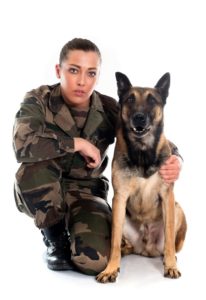Dogs around the world have followed warriors and soldiers into combat as far back as history records stretch. The Egyptians, Greeks, Persians, Romans and many other early civilizations used dogs as sentries or on patrols. Some early armies even brought dogs into battle. Today’s active service dogs are highly skilled and valuable. Their primary jobs are to detect bombs, landmines, weapons, and drugs—and their 98% accuracy (on average) makes them priceless companions for modern troops. Many dogs also track enemies (or lost friendlies) and protect assets and personnel.
To qualify for training as a military canine, dogs must have a keen sense of smell and be physically powerful and healthy, easy to excite about the next challenge, and strongly motivated by rewards. Even so, only around half of initial canine recruits—whether at land, air, or sea facilities—make it through training. The breeds and mixes most often used for military work are German Shepherds, Labradors, and Belgian Malinois. Interesting fact: Trainers use a specialized vocabulary of cues to avoid confusing the dog in tense battlefield conditions where people might shout words otherwise common in dog training, like “stay,” “come around,” “no,” etc.


